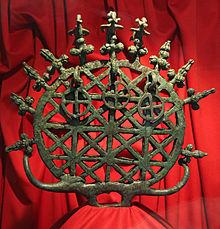
Back Bronstydperk Afrikaans Bronzezeit ALS ናስ ዘመን Amharic Edat de Bronce AN कांस्य युग ANP العصر البرونزي Arabic عصر برونزى ARZ ব্ৰঞ্জ যুগ Assamese Edá del bronce AST Tunc dövrü Azerbaijani

| Bronze Age |
|---|
| ↑ Chalcolithic |
| ↓ Iron Age |
| History of technology |
|---|
The Bronze Age (c. 3300 – c. 1200 BC) was a historical period characterised principally by the use of bronze tools and the development of complex urban societies, as well as the adoption of writing in some areas. The Bronze Age is the middle principal period of the three-age system, following the Stone Age and preceding the Iron Age.[1] Conceived as a global era, the Bronze Age follows the Neolithic, with a transition period between the two known as the Chalcolithic. The final decades of the Bronze Age in the Mediterranean basin are often characterised as a period of widespread societal collapse known as the Late Bronze Age collapse (c. 1200 – c. 1150 BC), although its severity and scope are debated among scholars.
An ancient civilisation is deemed to be part of the Bronze Age if it either produced bronze by smelting its own copper and alloying it with tin, arsenic, or other metals, or traded other items for bronze from producing areas elsewhere. Bronze Age cultures were the first to develop writing. According to archaeological evidence, cultures in Mesopotamia, which used cuneiform script, and Egypt, which used hieroglyphs, developed the earliest practical writing systems. In the Archaeology of the Americas, a five-period system is conventionally used instead, which does not include a Bronze Age, though some cultures there did smelt copper and bronze. Indigenous metalworking arrived in Australia with European contact.
In many areas bronze continued to be rare and expensive, mainly because of difficulties in obtaining enough tin, which occurs in relatively few places, unlike the very common copper. Some societies appear to have gone through much of the Bronze Age using bronze only for weapons or elite art, such as Chinese ritual bronzes, with ordinary farmers largely still using stone tools. However, this is hard to assess as the rarity of bronze meant it was keenly recycled.
- ^ "The Metal Ages". Encyclopædia Britannica. 16 September 2024.